Move More & Move Well Monthly Recap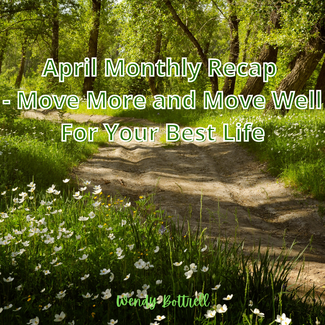 This month we have shared ideas to help you develop a move more and move well mindset for your best life. It is our belief that getting up and moving more is one of the best things you can do for your life and the life of all your family, mind, body and spirit. Lead by example. The Move More and Move Well topics we discussed this month:
We enjoy moving each and every day. Our movement practice is a part of our healthy and fit lifestyle and there is no question today that moving more and moving well is an essential part for anyone looking to improve how they feel. At the end of the day all the ideas and tips will not get you moving well unless you take action. This is where you MUST clarify your WHY and get moving. Your feedback is invaluable! We'd love to hear from you! Share your thoughts, ideas, or comments below, and let's continue to inspire each other on our paths to wellness. If you ever need guidance or support, don't hesitate to reach out. We recently wrote a blog post that might interest you here - Craft a Life Aligned with Your Core Values - https://bit.ly/3UZ8FG7 We're here to help you thrive every step of the way. Let's Build Health & Fitness - Join Our Newsletter Today! Sign Up Today! https://bit.ly/42Hf0aR
0 Comments
Mental Benefits Of Getting Outdoors & Moving More We enjoy getting outdoors for a walk each morning. There are so many benefits to this activity for our health and wellbeing. Today we want to share with you The Three Major Mental Benefits Of Getting Outdoors And Moving More. Being physically active has been shown to have a significant benefit to how we feel. In fact, exercise is believed to be about as beneficial an anti-depressant in the treatment of mild to moderate depression. Here is an article from the Harvard Health Letter - Exercise is an all-natural treatment to fight depression to provide more details on this topic - https://www.health.harvard.edu/mind-and-mood/exercise-is-an-all-natural-treatment-to-fight-depression Keeping the body active has been shown to curb daily depression and over time has shown promising figures on keeping depression at bay. It is important to keep up with a consistent fitness practice. Make your movement practice a lifestyle and not a temporary fix. While it is not necessary to do vigorous exercises, it is important to recognize your mood when doing these physical movements. A recent study conducted by JAMA Psychiatry showed that “Participants showed a 26% decrease in odds for becoming depressed for each major increase in objectively measured physical activity.” Overall, collective studies have shown that people report a higher degree of energy, excitement, satisfaction and self-esteem, and a lower level of tension, sadness and exhaustion when exercising on a regular basis, especially when utilizing the outdoors. People who work out outside often claim that they are more likely to exercise again than those who sit indoors. The following benefits of outdoor activities can lead you to you feeling your best in no time: • Soak in the sunshine -- Analysis heavily suggests that vitamin D has been shown to have a more positive impact on your internal mood as opposed to remaining in artificial light. While researchers are still studying what vitamin D can do for our bodies, multiple reports have stated that it can shield us from a wide variety of illnesses, from osteoporosis and cancer to heart attacks and depression. A study conducted by Brigham Young University research center concluded, “Getting some sun (10-15 minutes) a week increases your serotonin and helps you stave off Seasonal Affective Disorder (SAD) and sun exposure can also help people with anxiety and depression, especially in combination with other treatments.” More research has shown that three-quarters of Americans were coming up short on Vitamin D. No matter what the weather is, take the time to go outside and breathe the fresh air. Your mind will thank you for the much-needed respite. • Put down the electronics -- Being inside, it is naturally more enticing to be sedentary than if you are outside. Studies have shown that our brains are wired from a noticeably young age to understand that being outside means moving around and indoors bringing calmer activities, such as reading or watching tv. Some activities could look like spending more time walking to local area stores if possible, plant a garden, sweep the yard, or other things that can keep you up and away from your screen. Children are particularly at risk of consuming large quantities of television, playing video games or using tablets. NPR.org reported as of 2017, “42 percent of young children now have their very own tablet device – up from seven percent four years ago.” A great way to encourage yourself and your family to exercise together. Head out and make some fun memories. If I could give you one tip today for the best life of your children is this tip. Get them off the computers, tablets and especially the games. There is nothing about this activity which is good or beneficial for children. • Utilizing Green Exercise – Dr. Georgina Harper from Wales collected a multitude of information to better understand exactly how being outside really does affect the mood. Among many interesting conclusions, Dr. Harper reported, “Green Exercise connects people to nature in their local areas, often through collective activities with social benefits. It is one of the most cost-effective ways of improving physical and mental wellbeing.” Furthermore, researchers in Britain have worked on the theory that fitness, in general, provides additional mental health benefits. Appropriately calling this the 'green workout.' These researchers have found that even five minutes of exercise in nature will help you feel better. Other studies have demonstrated that children, under 18, with attention deficit hyperactivity disorder (ADHD) can focus more quickly and return to “base level” in a much shorter time when being outside and engaging in physical activity. This is a great time to gather up the family and go for a bike ride or a walk to the park. Encouraging each other and spending time together will leave smiles on everyone. Whatever activity you choose for yourself, remember to check in with physical health first. If you are more limited, even a walk around the neighbourhood is always beneficial. If your up for a bigger challenge, try a light jog to the store. Use this time to relax mentally. Find your baseline. As Author Elle Sommer once said, “Don’t let the circumstances of your life dictate how you feel. A good mood does not have to depend on external conditions. Peace of mind comes the moment you choose to be peaceful with any situation.” Your feedback is invaluable! We'd love to hear from you! Share your thoughts, ideas, or comments below, and let's continue to inspire each other on our paths to wellness. If you ever need guidance or support, don't hesitate to reach out. We recently wrote a blog post that might interest you here - Craft a Life Aligned with Your Core Values - https://bit.ly/3UZ8FG7 We're here to help you thrive every step of the way. Let's Build Health & Fitness - Join Our Newsletter Today! Sign Up Today! https://bit.ly/42Hf0aR A Simple Move Well Plan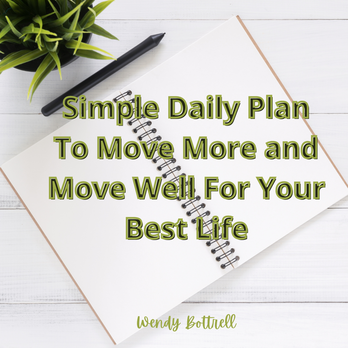 As we are coming to the end of the month with our topic of Move More and Move Well today we want to share a Simple Daily Plan To Move More and Move Well For Your Best Life. Many people believe that it is not as easy as it sounds to commit ourselves to move daily. It is our belief that this is not true. We may write it down in our journal, we may prepare ourselves the night before in our sleep, but when the hustle-bustle begins, we lose ourselves in the same poor habits as we experienced the day before and the day before that. In fact, humans are creatures of habit, and the concerns of living a life that results in poor health are a great exhibit of it. This is an easy-to-follow yet effective way to implement daily movement into your practice, especially if you are currently experiencing sedentary behaviour more often than not. 1) The most important idea we can share with you is for you to create a strong WHY. WHY is it important for you to begin a practice of moving more and moving well? We wrote about this and invite you to learn how to do this here - https://wendybottrell.weebly.com/blog/what-motivates-motivates 2) Practice mindfulness in the earlier parts of your day with a focus on being active. Whether that be done through meditation, affirmations, breathing exercises, journaling, or even just an internalized dialogue with yourself on the circumstance you are in. There is more benefit to be had, though, from ACTING on mindfulness rather than just thinking about it. The act of mindfulness in the morning is ideal for combatting sedentary behaviour because it will help you focus on activity from the start. A more clear-minded approach provides a sense of personal motivation. 3) Set small daily goals with rewards. This can be difficult for two reasons; a) it is hard to determine what goal best fits into your day or b) it is hard to narrow down a reward that will motivate you. Though, it has been found that this habit is actually one of the most effective ones there is. As ridiculous as it sounds, we will always be that child who eats all of their dinner for their favourite dessert. This habit requires us to look within ourselves to determine what is the best way to spark motivation. Does it suffice to bargain with television time if you are still consuming hours of television? Probably not. Does it suffice to offer yourself a glass of wine for an accomplishment if you don’t drink often? Potentially. This part of proactive planning is entirely personal, but that doesn’t revoke its potency and simplicity once a reward system is established. This is done via either understanding your own desires or removing things that are enjoyed in your life and using them as a reward. 4) Create a way to hold yourself accountable. As adults, we are responsible for our ability to focus on our goals. We must live with self-discipline, for our best life. Being personally accountable for your physical activity takes more effort than we recognize at face value. There are external ways to apply that practice, such as joining social groups that are focused on physical activity or planning your own social gatherings, such as a nature walk with friends. Using your technology to your advantage, some applications can limit your time on social media other websites to help promote less screen time and remind you of how long you've been distracted from physical life at the moment. Some applications will remind you to get up and walk, or even just stand, such as what is available with the Apple Watches. Utilizing a health tracker of some sort can be someone's best bet for noticing sedentary behaviour, as it is misunderstood in more cases than not. These four practices are a great way to begin planning daily movement. Applying them to your daily schedule will take time and patience, especially with yourself. Still, by doing so you are working towards healthier habits and more movement— both of which are beneficial in the long run, regarding the longevity of a person's life. Sedentary behaviour is not simple to combat but having the right approaches can help make it feel that way at times. Your feedback is invaluable! We'd love to hear from you! Share your thoughts, ideas, or comments below, and let's continue to inspire each other on our paths to wellness. If you ever need guidance or support, don't hesitate to reach out. We recently wrote a blog post that might interest you here - Craft a Life Aligned with Your Core Values - https://bit.ly/3UZ8FG7 We're here to help you thrive every step of the way. Let's Build Health & Fitness - Join Our Newsletter Today and recieve The Free Beginners Guide To Healthy Eating! Sign Up Today! https://bit.ly/42Hf0aR Move More For Your Best Fit Life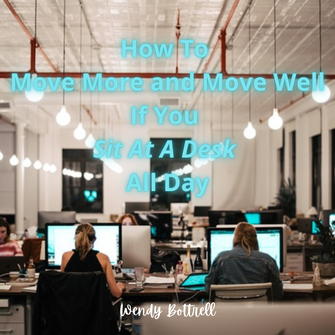 We are discussing moving more and moving well this month. It is our belief that this is an important topic especially during these times of 2020/2021. Today we are sharing ideas on How To Move More and Move Well If You Sit At A Desk All Day. Those working a 40-hour week at a desk job are spending a large portion of each day sitting down, burning few calories, and getting a very little exercise. This is not good for your health for many reasons and moving more does help your body stay healthy. Unlike a physical job in which people tend to move a lot during the day, a desk job while still tiring does not do much for a healthy lifestyle or in weight control. People work for 8 hours a day, might commute 1-2 hours in a car and may return home at night to sit in front of a television or a computer to unwind. There is little chance of any organic exercise in this process so time must be made. A sedentary lifestyle is not healthy in the long term so we need to find ways to keep ourselves healthy despite our desk jobs. Get Control of Your Diet Between donuts in the break room and bowls of candy on work colleagues' desks, there may be a temptation to eat unhealthy amounts of poor quality Frankenfoods. This is why practicing discipline is important when you sit at a desk all day. Avoid the empty snacks and get used to saying no when someone brings in cupcakes or some other unhealthy food. Remember to stay hydrated throughout the day, not only does it fight off hunger but it also helps you stay energized. According to WebMD the so-called 3 pm lull is often caused by dehydration so keep a good supply of water on hand. (source). Lunch Break Walking It would be our suggestion to eat lunch and get out for a walk to get active in your 30–60-minute lunch break. Find a like-minded work colleague who wants to get active as well and walk together. It’s not just misery that likes company, workouts also benefit from a little group motivation. You may think that walking at lunch will leave you tired for the rest of the day but the opposite is actually true. When we exercise, we help boost energy in the body and also release some feel-good hormones in the brain. We actually return from break refreshed and in a generally better mood if we get the heart pumping a little bit with a short walk. Standing Desk This new innovation prevents you from sitting all day as it adjusts from standing to sitting so you can get on your feet several times a day. Exercise at the Desk Just because we are sitting at a desk does not mean we cannot get some exercise at the same time. This can be walking or moving when on the phone, getting up from the office chair for a 2-minute stand and stretch session each hour or maybe even doing a set of 10 bodyweight squats with the goal of doing 100 squats during your workday. The idea is to find creative ways to move more in your day. By nature, sitting at a desk is often physically restricting however with some inventive thinking you can find ways to move more and move well each and every day. It may just be a lap around the office every hour as a short break or something more intense in whatever way fits your job and your lifestyle. Your feedback is invaluable! We'd love to hear from you! Share your thoughts, ideas, or comments below, and let's continue to inspire each other on our paths to wellness. If you ever need guidance or support, don't hesitate to reach out. We recently wrote a blog post that might interest you here - Craft a Life Aligned with Your Core Values - https://bit.ly/3UZ8FG7 We're here to help you thrive every step of the way. Let's Build Health & Fitness - Join Our Newsletter Today and recieve The Free Beginners Guide To Healthy Eating! Sign Up Today! https://bit.ly/42Hf0aR How To Make Yourself Top Priority By Moving More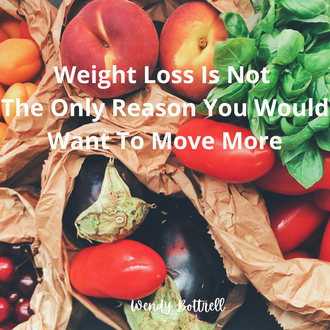 As we discuss the importance of moving more and moving well today, we want to share ideas on why weight loss is not the only reason you would want to move more. It might be a surprise! Check it out and be sure to let us know any thoughts or questions you have in the comments. More than ever, our physical and mental health are being taxed daily. We spend so much of our free time, and lately, work time, sitting in front of our computers. A report put out by Hootsuite and We Are Social claimed, that as of 2019, “on average, adults are spending 6 hours and 42 minutes online each day. Half of that is spent on mobile devices.” As of this past year, these figures have almost doubled. While spending much of the day on electronics, our physical health seems to be taking a back seat. Along with not being mindful of our bodies, our mental health suffers too. Let us look at the best ways to start feeling your best, both internally and externally: • Shake off the “foggy brain” – Nothing can bring you down faster than having an “off” day. It feels as if someone has popped your balloon. But shifting your priorities enhances the brain's circulation-feeding it with oxygen and nutrients that it requires to function. Even a task such as stopping one activity to grab a glass of water can help the brain reset itself. What is better is a short walk, about 10 minutes. While the brain can accept approximately 80 percent of the information to feel in control of our environment, it is important to recognize the other 20 percent, according to a study titled ‘Information Overload’. • Manage stress levels intuitively — When our bodies feel high levels of stress, ironically, doing some form of physical exercise, often is your greatest asset. Physical exercise is a wonderful way to alleviate stress, particularly if you are upset about a situation. On a biochemical basis, exercise raises the level of feel-good endorphins. Remember to take it slow at first. If one activity does not seem to help, try another. Keep working on the best ways you feel most comfortable which will inevitably aid your mental health too. • Get a good night's rest – One of the hardest parts of being mentally stressed is the lack of good quality sleep that we require to function well daily. Daytime activities can affect us as much as nighttime activities when it comes to sleeping well. Dozens of research studies have found that exercise has a beneficial impact on sleep efficiency and length. So not only does it make you sleep better, but it gives your mind a chance to rest also. It is best to keep the hard exercises, such as running in the morning or early evening hours. Try a short walk or light jog no more than three hours before bed. • Encourage a happy tummy – When we are stressed from the day, it can be easier to grab a pizza and settle in for the night. Eating real organic food cooked in your own kitchen will help you to feel your best every day. Intermittent Fasting can be a good option to include for good health overall and we wrote about this topic here bit.ly/48RKixr In between, make sure to drink plenty of water. Your mind and body will thank you. • Reducing chronic health problems – The more we lay about, the impact often affects us in the long term. Again, exercise is the key. Evidence shows that a lack of physical activity affects almost every cell, organ, and system in the body that induces sedentary deterioration and accelerated ageing. However, just that time that you take to exercise, helps in reducing chronic illnesses including: o Obesity o Hypertension o Type 2 diabetes, insulin resistance and pre-diabetes o Heart disease, stroke, and high cholesterol o Depression and anxiety o Several types of cancer o Premature death • Tracking your inflammation levels -- A fast inflammation refresh: acute short-term inflammation is healthy and normal. Low-grade chronic inflammation may lead to all types of health problems. It can raise the risk of autoimmune diseases, which can also contribute to disease flare-ups. Exercising, momentarily increases inflammation – which is healthy for you. Daily exercise decreases inflammatory markers and improves anti-inflammatory compounds in the body. Simply put, exercising on a regular schedule will help you quiet down future systemic inflammations. • Curbing the pain -- If you feel some sort of constant or sporadic discomfort, exercise will be your new best friend. If you are sore, it may be the last thing on your mind to go for a stroll or to the gym. However, the reality is, exercising, even as little as 15 minutes, can help ease the affliction. Research has shown that exercise can enhance pain tolerance, reduce pain sensitivity, and enhance the quality of life for those who suffer chronic pain. Check-in with your body. Is exercise helping or could there be another source? Reaching out to your doctor for a full physical will be beneficial. • Keep your mood up – Physical activity is not only good for your body—it is healthy for your mind, too. In fact, walking is one of the top activities encouraged by therapists for depression. Physical exercise sends a signal to the brain to release endorphins. These molecules are responsible for feelings of satisfaction, calmness, and well-being. Endorphins can have pain-relieving and immune-boosting properties. People with chronic pain and depression also have lower levels of endorphins than average. Keeping up with your physical activity leads to living a healthier lifestyle which is all essential to improving your mood and long-term health conditions. • Do not forget those pearly whites – Brushing and flossing, it turns out, are not the only keys to a good smile, claims Mohammad Al-Zahrani, DDS, Ph.D., former associate professor at the University of Case Western Reserve. Exercise frequently plays an important part. Dr. Al-Zahrani found that “adults who had 30 minutes of moderate exercise 5 or more days a week were 42 percent less likely to develop periodontitis, a gum condition that is more common as you get older. Working out can thwart periodontitis the same way that it does heart disease—by lowering the level of inflammation that induces C-reactive protein in the blood.” As we end our discussion today on moving more and moving well, take care of your body and mind equally. They each require stimulation, relaxation, and kindness. As Author Mandy Hale quoted, “It is not selfish to love yourself, take care of yourself, and to make your happiness a priority. It is necessary.” Your feedback is invaluable! We'd love to hear from you! Share your thoughts, ideas, or comments below, and let's continue to inspire each other on our paths to wellness. If you ever need guidance or support, don't hesitate to reach out. We recently wrote a blog post that might interest you here - Craft a Life Aligned with Your Core Values - https://bit.ly/3UZ8FG7 We're here to help you thrive every step of the way. Let's Build Health & Fitness - Join Our Newsletter Today! Sign Up Today! https://bit.ly/42Hf0aR 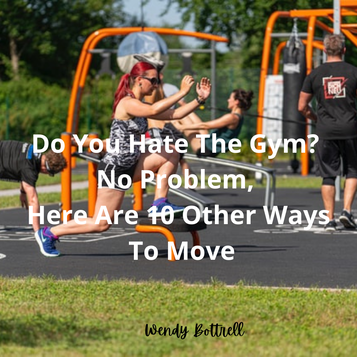 We are discussing ideas to help you move more and move well this month. Getting up off the couch is so vital to living your best healthy life and today’s topic is Do You Hate The Gym? No Problem, Here Are 10 Other Ways To Move. Now, we definitely enjoy moving well and lifting weights. In fact, we get out every morning for at least a 5 km walk and most afternoons we do our weight training at home. Yet, going to the gym is not the only way to get in shape or even just to remain active. Here are ten ideas to stay moving without having to think that going to the gym is the only option to move well. 1) Use your local sidewalks or trails for cardio activities. This can include walking, running, biking, skating, or whatever it is that takes you from point a to point b. Cardio is excellent for the heart especially, which is a significant concern with insufficient activity levels. Trail running is a great alternative to public running if you are particular about taking to the streets. There is a sense of seclusion and privacy from this habit, and it can be refreshing to be in nature and around serene views. That in itself tends to feel motivating regarding improving your health. 2) Invest in some fitness equipment and start practicing with video tutorials at home. Whether you rent a DVD from the library or watch some YouTube instructions, video tutorials are beneficial. If you find use from this idea, consider signing up for virtual classes. 3) Use your indoor stairs or public stairs. Running stairs is a fantastic workout and we have used this in our training for years. This is not something that everyone can do, as we don’t all have indoor stairs. As useful as a stair climber can be, the real thing is just as handy. You can utilize stairs in your home if you have them or find a local spot where foot traffic is limited and can pace comfortably. The up and down may seem tedious, but no more or less than what is found at the gym. 4) Practice balancing movement during sedentary activities. For example, when you are at work, make it a point to walk to the furthest away bathroom or use your lunch break to talk brisk walks or quick runs. Our lives' demands may not be adjustable in every way, but that does not remove the opportunity to become creative as to how we fit in these new ideas and intentions around movement. 5) Create social get-togethers around being active rather than for passive activities. This means instead of going out for a movie, maybe you and your friends go for a hike. This transition is simple and beneficial to everyone. 6) Take up a new hobby that includes an activity. Biking, skating, skiing, hula-hooping, dancing, and so on are great hobbies that can be of both emotional and physical benefit. Some may require a class, while others you can rent the needed equipment before you make any investment in gear. 7) Make movement pacts with yourself. This includes adjusting behaviour around your daily activities, such as remaining consistent with the practice of walking when talking on the phone. Other examples include taking breaks during work to walk the stairs briskly or to do a yoga flow by the desk, or even doing squats while you're waiting for food to cook. Taking time for your needs regarding movement, as well as remaining consistent with the approach towards the deeper, long-term value of it is a great way to avoid the gym while also staying proactive about being active. 8) Walk or ride a bike to local errands. This is not in everyone's scope, but it may be possible to walk to the grocery store rather than to drive in some situations. If this is the case, then tie those lases and take advantage of it. If walking isn't effective enough, consider riding a bike or rollerblading. Both are much quicker yet use very similar bodily systems as th that of walking/running. 9) Exercise at home. This is straightforward and much more accessible than we realize. There are so many ways to exercise with just your body, not equipment or gear needed (besides appropriate attire for a comfortable experience). Watching videos on movements or checking out a book at the local library can help provide visuals of the best exercises for the space you have and the bodily needs that need to be addressed. Working out from home is liberating and demanding all at once but is just as effective if you are doing it with enough endurance and consistency. 10) Begin and end the day with yoga or stretches. Beginning the day with a good movement practise is very beneficial to the mind and the body, especially when trying to gain the skill set of being more active. Becoming accustomed to increased daily movement does not happen overnight, so this is great for better habit-building. There are more than enough ways to remain active from home. Going to the gym is beneficial, but it indeed isn't the only option for movement and activity. Utilize this list as a reference while considering that there are countless ways to create a routine of movement without including a trip to the gym. Your feedback is invaluable! We'd love to hear from you! Share your thoughts, ideas, or comments below, and let's continue to inspire each other on our paths to wellness. If you ever need guidance or support, don't hesitate to reach out. We recently wrote a blog post that might interest you here - Craft a Life Aligned with Your Core Values - https://bit.ly/3UZ8FG7 We're here to help you thrive every step of the way. Let's Build Health & Fitness - Join Our Newsletter Today! Sign Up Today! https://bit.ly/42Hf0aR As we continue to share ideas to help you move more for your best life today is Fitness Friday - Move More – Move Well Tip - Build An Obstacle Course - Build yourself an obstacle course where you can jump, hop, stomp and zig zag. This will be something that is a workout, but much more fun than just running.
You can do this indoors or outdoors, today our workout video is an outdoor course, but whichever is easiest in your climate. Have fun with the obstacle course. Your feedback is invaluable! We'd love to hear from you! Share your thoughts, ideas, or comments below, and let's continue to inspire each other on our paths to wellness. If you ever need guidance or support, don't hesitate to reach out. We recently wrote a blog post that might interest you here - Craft a Life Aligned with Your Core Values - https://bit.ly/3UZ8FG7 We're here to help you thrive every step of the way. Let's Build Health & Fitness - Join Our Newsletter Today! Sign Up Today! https://bit.ly/42Hf0aR Prevent The Sedentary LIfe Tips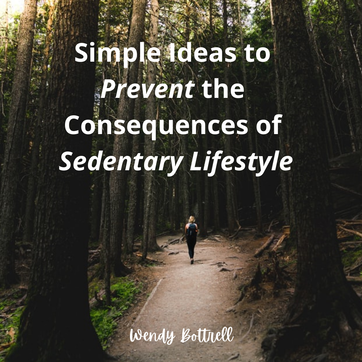 We are living in the times of a global health crisis and this month we are sharing ideas about moving more and moving well for your best life. Today’s topic is Simple Ideas to Prevent the Consequences of Sedentary Lifestyle. We like simple ideas that we can implement easily to make change. Check it out and be sure to let us know your thoughts in the comments. A Sedentary Lifestyle increases a person's risks for many ailments, but some are far graver than others, such as cancers, heart disease, and other life-threatening conditions/illnesses. There are many ways to prevent the consequences of living a sedentary lifestyle, though, and we are sharing a few simple ideas as a place to start.
Allowing yourself to utilize your daily activities to move your legs and increase blood flow is a privilege that we all have access to. Some significant shifts in lifestyle that can begin to improve your body’s overall ability to function more actively are:
This list is not limited to just these suggestions either. Everyone's lives are different and finding the best place to make these adjustments should be approached personally, considering health, even if some of the concerns are related to being sedentary.
Standing when you don't have to is essential to preventing the effects of long-term sedentary living. By doing so, you are forcing blood to begin circulation and putting expectations on your leg muscles, building their endurance to the improvements in lifestyle that are to come (hopefully). Think of it as you don't have to stand, but instead you NEED to stand. Check out this article on the benefits of standing - https://www.developgoodhabits.com/standing-vs-sitting/ Some universal ways to apply this practice to your lifestyle are:
These are small steps that are important to avoid the effects of a sedentary lifestyle.
This step is less about a specific action and more about a mindset that is needed. To prevent the effects of being too passive, a person must taper themselves into becoming more active. Starting small is very important, as it prevents any injury or unneeded strain on the body. Our muscular and bone systems are fragile, especially when they aren't used as often as they were meant to be. Starting small, setting goals, and executing them is step one to preventing the effects of this disease of the mind that plagues the body. Aiming for them to continue and grow is the next part of the transition. Some general ways to implement this sort of practice would be to start with small physical exercises that are readily available and can be expanded from. This includes but is not limited to:
This one is critical as it is something that most of us share in life; we have to go to work. For many of us, going to work may mean sitting all day, which does not work in one's favor when trying to combat the consequences that loom on the horizon of a sedentary lifestyle. If you are blessed enough to enjoy a job that keeps you moving yet still struggle with staying active, focus on practicing good movement daily by setting an alarm as a reminder. If you are not as lucky and spend a lot of your time working in a still position, then proactivity is your best bet. Being proactive at work means taking breaks to stand, walk, pace, and stretch your muscles as often as possible. This could be structured for the sake of consistency, or you could act on it upon recognizing your body is beginning to feel "stuck" or sore. This can be accomplished by listening to podcasts or music on the subject and wearing movement-friendly clothing. You are reminding yourself to remain active where possible is important when practicing avoidance of the complications that follow a sedentary lifestyle.
I saved the best for last. To prevent the consequences of living a sedentary lifestyle from burdening your life, you must remain consistent to your practice of good movement activity. This means enforcing discipline upon yourself, taking accountability for the moments you don’t practice discipline, and taking pride in the moments you do. We shared some ideas to help you with discipline here - https://wendybottrell.weebly.com/blog/simple-yet-effective-self-discipline-hacks-for-your-best-life Staying consistent with your small goals and adjusting them when the time comes is essential for anyone to avoid the impact of health that is connected to a sedentary life. Striving to avoid the consequences of living a sedentary lifestyle requires changing that lifestyle. This isn't something that can be easily accomplished overnight, nor is it something out of reach for anyone. Taking charge of our health is a responsibility we have to our mind and body. Take on these five practices with a serious approach and it is guaranteed to create noticeable change. Your feedback is invaluable! We'd love to hear from you! Share your thoughts, ideas, or comments below, and let's continue to inspire each other on our paths to wellness. If you ever need guidance or support, don't hesitate to reach out. We recently wrote a blog post that might interest you here - Craft a Life Aligned with Your Core Values - https://bit.ly/3UZ8FG7 We're here to help you thrive every step of the way. Let's Build Health & Fitness - Join Our Newsletter Today! Sign Up Today! https://bit.ly/42Hf0aR Be Inspired To Move More and Move Well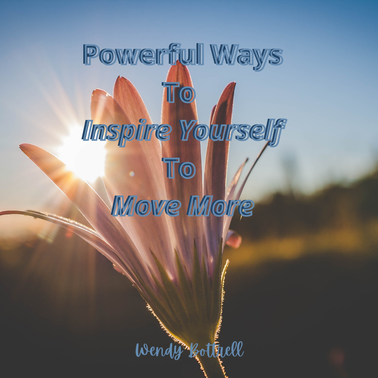 We know today more than ever that moving more is essential to our wellbeing. This month we are sharing ideas to help you move more and move well. Today our topic is Powerful Ways To Inspire Yourself To Move More. Be sure to let us know your thoughts in the comments. Sometimes we argue with ourselves about the simplest of things, like getting out of bed, yet those things are essential for us to proceed with our day with a sense of wellbeing. This trouble can extend into our inspiration/motivation to be more active. Here are 5 powerful ways to inspire yourself to move more. 1. Make a Vision Board Making a vision board can be beneficial to inspiration and motivation from a few angles. The visual reminder of what you are striving for can stimulate your mind to further thought about the images. This psychological effect can be very motivating for some. The repetition of the vision board should be strategic. You want to see it at the times when you are approaching moments of empowerment— where are you when you are finishing up your intention-focused physical activity? This is where you remind yourself of what you're working towards. This focal point of the vision boards highlights motivation's role in engaging in the goal, and in this case, is to move more. 2. Meditate on Your Goals Meditation is good regarding our focus. Meditation is the practice of mindfulness, but this does not mean a state of “emptiness”. Meditation works well for concentrating on our goals or focuses on life, primarily if we utilize audio input to the practice. Meditating with intent can be done in the form of manifestation monologue or encouraging and assuring affirmations. These can be out loud, as well as within our minds. Focusing on moving more during meditation could put us subconsciously in a higher state of mobility. It could lessen the stress we are applying to our joints, thus increasing our comfortability during movement. The experiences that occur when this practice is utilized also improve our conscious approach to moving more. These two shifts working cohesively can create a natural sense of motivation. 3. Empowerment Journaling Empowerment journaling is a great inspiration tool for increasing activity. It is useful both when doing the journaling but also when you are not feeling aligned with taking that moment to empower yourself, allowing the previous entries to work in your favor. If you already have a journal started, add in segregated sections to entries, or begin one from scratch. Fill entries with:
4. Celebrate your accomplishments Celebrating your accomplishments can be as simple as taking yourself out to eat to as eventful as having some friends over and seriously celebrating. The movement and activity related accomplishments in anyways life deserve acknowledgment, but recognition is not the same as a celebration. A great way to start this practice is by setting weekly goals and then planning the reward if you accomplish them. 5. Absorb Inspiring Material What classifies as inspiring material? Well, whatever it is that keeps you moving past your step count goal. Consider listening to inspiring music or podcasts when you're out walking, watch a documentary about fitness and health on your night off instead of the usual standup, or change your readings to an inspiring true story. Consuming inspiring material is excellent for motivating yourself, especially if you are moved by what people can accomplish. So, whether you’re in a funk and can’t figure out if it’s time to tackle that annoying yoga flow that you’ve been putting off or you’re genuinely struggling to change your lifestyle, inspiration and motivation are one of the more personal ways to get yourself moving. Your feedback is invaluable! We'd love to hear from you! Share your thoughts, ideas, or comments below, and let's continue to inspire each other on our paths to wellness. If you ever need guidance or support, don't hesitate to reach out. We recently wrote a blog post that might interest you here - Craft a Life Aligned with Your Core Values - https://bit.ly/3UZ8FG7 We're here to help you thrive every step of the way. Let's Build Health & Fitness - Join Our Newsletter Today! Sign Up Today! https://bit.ly/42Hf0aR Simple Weightlifting Tips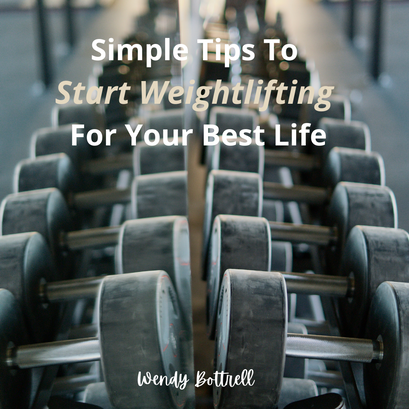 As we continue to share ideas to help you move more and move well today, we want to share some simple tips to start weightlifting for your best life. Just in case you are new to my blog I want to let you know that weightlifting is one of my favourite things to do. I have been lifting weights for almost 40 years and it has changed my life. So, if you are looking for an activity that will not only help you move more and move well maybe it is time for you to consider weightlifting. Maybe you want to take your health and fitness into your hands, if so welcome and be sure to let us know your thoughts on the simple tips to start weightlifting. When I first began down the path of weightlifting, I was extremely uncomfortable about joining a gym. In fact, I went 3 times to the gym and only got to the front door. I was not comfortable going in because I was about 100 lbs overweight and felt like I didn’t fit. All those hard bodies made me feel like I shouldn’t be there. This of course was not true. When I finally got my gym membership everyone in the gym was great and supportive. Over the next year I learned how amazing weightlifting was for me, enjoyed every single minute of this journey for me, reduced my weight by 100 lbs, and felt great. The gym experience and weight training is something that I continue to do this. It doesn’t matter whether it’s the first time you are considering weightlifting, or you are restarting a weightlifting program. Regardless, the important thing is that you’re here now, and wanting to make a change. Tips To Begin A Weightlifting Program 1. Start Slow - this is the most relevant tip you can follow, and why it is number one. You may hear the idea of lifting heavy or go big or go home. Yes, heavyweight is ideal for building strength, muscle, and even burning fat to an extent, but Rome wasn’t built in a day. It was built brick by boring brick. Start slow and begin where you are is how you must look at this adventure. Each workout is the stepping-stone for something bigger. Each 1-lb sized plate adds up to progress and ultimately achieving the goal you set out for yourself. Have patience and train consistently. 2. Begin With A 3 Day A Week Schedule - ideally, when you are new to weightlifting, a 3-day full-body workout is best. It gets your body accustomed to the kind of stimulus, offers sufficient recovery and helps you develop the habit of weightlifting. 3. Start With Compound Lifts- For at least the first 8 weeks of training, make the squat, bench press, and deadlift your three go-to movements. Gradually, afterwards, you will add other movements including but not limited to rows, shoulder presses, and arms. 4. Sleep Enough - the amount of sleep you get is related to the rate of your recovery as well as your capability to work out to your full potential. If you work out first thing in the morning, lack of sleep the previous night not only kills motivation but also may be downright dangerous. Muscle rebuilding doesn’t occur in the gym, it happens during sleep and active hours. 5. Do A Few Days Of Cardio - Most days of the week you will want to go for a walk. This is where you want to move more and move well, simply get out and move. Since you are weightlifting 3 days a week use the other 4 days to include some moderate to high-intensity cardio or HIIT training. Meaning a couple of days a week you can begin to do a walk/run and a couple of days do high-intensity training. 6. Do Not Stretch Before Your Workout – Warm Up - now this might be a surprise to some of you. You want to warm up your body for your weightlifting session. Use the warmup to prepare your mind and body for the workout. Stretching before a workout was a common practice many years ago however this thinking has now changed. “Recent studies caution people away from stretching before workouts, suggesting it actually impedes your body’s performance. According to this research, runners run more slowly, jumpers jump less high, and weightlifters lift more weakly by stretching, without significantly insuring against injury during their exercise.” (source) 7. Consume Enough Protein - One small way to improve body composition is by consuming enough protein. Proteins are the building blocks of muscle tissue, so when testosterone does signal for muscle synthesis to ensure, you have enough raw material handy. 8. Track Each Workout – be sure to track each workout. What exercises were included that day, what weight was used per set and how you felt during that day’s session. This helps to see the progress you are making. 9. If In Doubt, Get A Trainer - if you wish to have as little downtime as possible, hire a personal trainer from inception. This will reduce your learning curve and allow faster progression as well as expert guidance. 10. Stretch At The End Of Your Workout - this is important for joint recovery, stretching the muscle fascia and promoting blood flow to and from the muscles. There you have it our Simple Tips To Start Weightlifting For Your Best Life. Practicing weightlifting using these tips will take you a long way to success in your health and fitness journey. Your feedback is invaluable! We'd love to hear from you! Share your thoughts, ideas, or comments below, and let's continue to inspire each other on our paths to wellness. If you ever need guidance or support, don't hesitate to reach out. We recently wrote a blog post that might interest you here - Craft a Life Aligned with Your Core Values - https://bit.ly/3UZ8FG7 We're here to help you thrive every step of the way. Let's Build Health & Fitness - Join Our Newsletter Today! Sign Up Today! https://bit.ly/42Hf0aR Myths & Facts About Living A Sedentary Lifestyle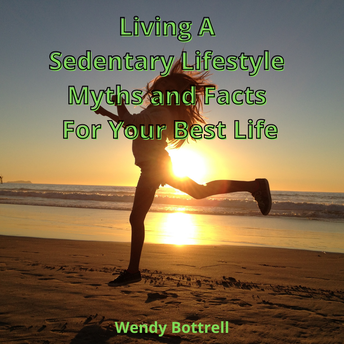 As we continue to share ideas on the sedentary lifestyle and wanting to help you move more today, we are talking about the myths and facts. Our topic today is living a sedentary lifestyle myths and facts for your best life. "The Top 4 Causes of Medical Problems: stress,negative mindset,poor diet, sedentary lifestyle." - Author: Charles F. Glassman We know today that physical inactivity has led to the rise of sedentary disease, a metabolic syndrome that increases the risk for chronic medical conditions. What Does Sedentary Mean? This comes from the Latin word sedere, meaning to sit. Examples of sedentary activities include: • Driving or riding in a car • Working on a computer • Sitting in a meeting • Watching TV • Reading Simple to understand, right? Monitoring sitting time is important for two reasons. First, sitting time decreases the time available for moderate-to-vigorous activity. Secondly, the more sitting time replaces light-intensity activity, the less overall activity a person does. According to a study published in the Exercise and Sports Science Reviews journal, two hours of light intensity activity equals 30 minutes of moderate activity like walking. There are common misconceptions about sedentary disease that are valid to address. Here are five important myths and facts to consider. Fact number one is sedentary jobs are a primary concern for those living sedentary lifestyles. According to the American Heart Association, sedentary jobs have increased by 83% since 1950 in the United States. Fact number two is sadly, only 20% of the population meets the criteria needed to be classified as performing a regular activity. Physical activity is only important for younger people is a common myth. After a certain age, there is no need to monitor that sort of thing. The truth is physical activity is essential for everyone. The ageing face even more health concerns and since sedentary behaviour provokes a list of diseases and ailments, it is in the best interest of those who are at higher risk to remain vigilant. The World Health Organization recommends that anyone over the age of 65 get at least 150 minutes of moderate aerobic physical activity each week. I have no time to exercise! Another myth and the most common excuse that is 100% false. The suggested 30 minutes a day, 5 days a week by the World Health Organization can be done in small spurts. Maybe there is time to do a minute of fast-paced squats before you take off to work, a brisk walk for your phone meeting, and the opportunity to use the stair climber after work while you're waiting for your appointment down the street. Standing is just as good as walking when avoiding being sedentary is another myth. Though standing is a way to combat sedentary behaviour, it is not a long-term solution, nor does it substitute walking. Being sedentary means that you are not moving your muscles adequately, which can be done effectively through a combination of exercise and daily physical activities. The final myth is that doing 30 minutes of physical activity a day solves the concern of being sedentary. Wrong! Though that 30 minutes truly counts, the rest of the day and how it is spent is essential. Sedentary behaviour is when the majority of a person’s time is spent not using their muscular system, not standing- usually sitting or lying down. If this is the trend for the day other than that 30 minutes, then sedentary disease is a concern. While researchers and doctors have previously promoted active exercise, newer research points to the need for exercise and general movement. Even light-intensity activities help protect your body from sedentary disease. Scientists now know that the longer you sit, the greater your risk for health problems. Regular movement and active exercise both play a role in preventing the health problems associated with sedentary disease. Your feedback is invaluable! We'd love to hear from you! Share your thoughts, ideas, or comments below, and let's continue to inspire each other on our paths to wellness. If you ever need guidance or support, don't hesitate to reach out. We recently wrote a blog post that might interest you here - Craft a Life Aligned with Your Core Values - https://bit.ly/3UZ8FG7 We're here to help you thrive every step of the way. Let's Build Health & Fitness - Join Our Newsletter Today! Sign Up Today! https://bit.ly/42Hf0aR Move Well - Prevent The Consequences Of A Sedentary Lifestyle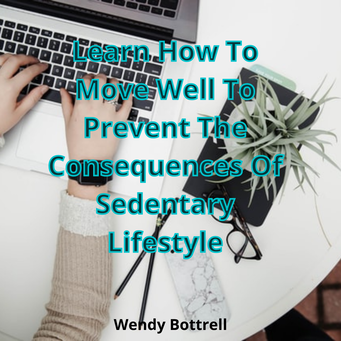 Our topic this month is Move More – Move Well. We feel it is an important topic and today we are sharing ideas to help you Learn How To Move Well To Prevent the Consequences of Sedentary Lifestyle A sedentary lifestyle increases a person's risks for many ailments, but some are far graver than others, such as cancers, heart disease, obesity and its related implications and other life-threatening conditions and illnesses. We have included a link to an article from Hopkins Medicine to provide a bit more info on why moving more and moving well is so important for your health and fitness. https://www.hopkinsmedicine.org/health/wellness-and-prevention/sitting-disease-how-a-sedentary-lifestyle-affects-heart-health • Walk when you have the chance and when you can choose to do so. It is as simple as choosing the stairs over the elevator. Allowing yourself to utilize your daily activities to move your legs and increase blood flow is a privilege that we all have access to. For example, take mini walks at work, 5 minutes for every hour you’re at the desk, walk to the furthest bathroom, walk-in place during TV commercials, park further away and walk around while on the phone. Another idea is to go places that require you to walk, such as the zoo versus a movie theatre. • Standing when you don't have to is essential to preventing the effects of long-term sedentary living. By doing so, you are forcing blood to circulate to your limbs. Some examples include standing on public transport, standing for 15 minutes every 3 hours when at your desk or get a standing desk, stand while on phone, stand during commercial breaks and stand while reading. • Start small but aim big. This step is less about a specific action and more about a mindset that is needed. Starting small by setting minor goals and executing them is step one to preventing the effects of this disease of the mind that plagues the body. Aiming for them to continue and grow is the next part of the transition. • Stay consistent. To prevent the consequences of sedentary disease from burdening your life, you must remain consistent with your practice of regular activity. This means enforcing discipline upon yourself, taking accountability for the moments you don’t practise discipline, and taking pride in the moments you do. Staying consistent with your small goals and planning for long-term objectives is essential for anyone to avoid the impact of health that is connected to the sedentary disease. How will use these move more - move well tips to help you live your best active lifestyle? Share any comments or ideas below. Your feedback is invaluable! We'd love to hear from you! Share your thoughts, ideas, or comments below, and let's continue to inspire each other on our paths to wellness. If you ever need guidance or support, don't hesitate to reach out. We recently wrote a blog post that might interest you here - Craft a Life Aligned with Your Core Values - https://bit.ly/3UZ8FG7 We're here to help you thrive every step of the way. Let's Build Health & Fitness - Join Our Newsletter Today! Sign Up Today! https://bit.ly/42Hf0aR Move Well by Tracking Your FitnessWe are sharing ideas this month to help you move more and move well. Today our topic is Use a Fitness Tracker to Help You Move More For Your Best Life. Have you heard the famous quote by Peter Drucker - “If you can’t measure it, you can’t improve it.” Move More Tips - Wear A Walking/Fitness Tracker - Do you know how much you sit each day? Do you move well and work out daily? If you struggled with answering these questions, you are probably sitting more than you realize. And if you want to truly make sure you are moving enough, it’s time to invest in a walking/fitness tracker that can help tell you when you need to move more. There are so many benefits to moving more and moving well each day. If you are practicing move more then using a walking/fitness tracker will help you measure your results. The benefits to move more and moving well are: • Improves learning concentration and memory • Helps improve mood • Helps relieve stress • Helps with better sleep • Helps improve the immune system • Helps improve vitality • Helps improve heart health • Helps improve bone health All important to help you live your best healthy/fit life, right? We think so. In 2017 during a stressful life event, I decided to go out every day for a walk in my neighbourhood. I did this for a year in all kinds of weather. How do I know how far I walked? I used an app on my phone that counted steps. I walked Over 3 million steps in one year. Walking has helped me get outside every day, move well, reduce stress, improved my sleep and helped me think through complex life and business issues in my life. You can read about this here and here I used the walking app and joined a Monthly walking challenges and did a minimum of 200,000 steps per month. I continue my practice of getting out for a morning walk to this day. Do you get out for a daily walk using a walking tracker/app? IYour feedback is invaluable! We'd love to hear from you! Share your thoughts, ideas, or comments below, and let's continue to inspire each other on our paths to wellness. If you ever need guidance or support, don't hesitate to reach out. We recently wrote a blog post that might interest you here - Craft a Life Aligned with Your Core Values - https://bit.ly/3UZ8FG7 We're here to help you thrive every step of the way. Let's Build Health & Fitness - Join Our Newsletter Today! Sign Up Today! https://bit.ly/42Hf0aR Live An Active LIfestyle By Moving More and Moving Well Today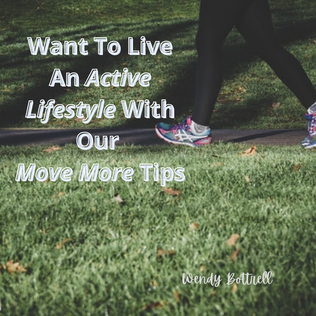 This month our topic is Move More – Move Well. You’ve heard the saying “sitting is the new smoking”, right? Here is an article that will help you understand the sitting/smoking debate a little better - https://theheartfoundation.org/2019/08/10/is-sitting-the-new-smoking/ With that said we will be sharing ideas to help you move more and if you choose to move well over the next month. Today’s topic is Want to live an active lifestyle with our move more tips. Be sure to get in touch with us and let us know how we can help you. Move More Tips to Live an Active Lifestyle 1. Take a Break Every Hour If you find yourself sitting at work or at home, make it a point to take a break for each hour you spend sitting. If you work in an office setting, this can be a quick trip to the water cooler to refill your water bottle, a walk to the bathroom, or even just you are standing and stretching for 2-3 minutes. Whatever works for you, just move for two to five minutes for every hour. To begin practicing moving more we recommend setting a timer to get you up and moving each hour. 2. Drink Lots Of Water First of all, drinking pure, clean water is good for all of your body systems, but besides just that, drinking water will make you need to take more frequent bathroom breaks. Frequent bathroom breaks are the best way to have an excuse to get up when you work in an office setting. Plus, you’ll have to make extra trips to refill your water bottle too. 3. Walk When You Talk On The Phone This is a practice we have done for years. There is something therapeutic about walking and talking so we use this tip regularly. Sometimes you may need to take a conference call, or maybe you are spending time talking on the phone with a friend or relative for hours on end. No matter who it is, move while you are talking on the phone with them. You can move, or if you are anything like me, I look out the window at nature. Consider repurposing your phone time into movement so you aren’t spending a half-hour phone call sitting in place. 4. Eat Outside As the weather is now getting warmer here where we live this tip is practical for a couple of reasons. However long your lunch break may be, consider taking your lunch outside. This encourages you to leave your desk and go for a little walk, even if it is just down the stairs and out the door. You could even order lunch for pick up nearby and walk to go pick it up on your lunch break to add even more steps to your day. 6. Consider Scheduling Walking Meetings If your job involves scheduling a lot of meetings, see if some of the people you are meeting with would be willing to go for a walking meeting instead. If the weather is nice, consider an outdoor walking meeting even. Studies have actually shown that walking can help the creative juices flow as it pumps more blood and oxygen to the brain! And if your someone who finds meetings boring, this will help make them more interesting. However, do note that walking meetings generally only work when you are meeting one or two other people. How will use these 5 moves more tips to help you more move and move well for your best active lifestyle? Share any comments or ideas below. Your feedback is invaluable! We'd love to hear from you! Share your thoughts, ideas, or comments below, and let's continue to inspire each other on our paths to wellness. If you ever need guidance or support, don't hesitate to reach out. We recently wrote a blog post that might interest you here - Craft a Life Aligned with Your Core Values - https://bit.ly/3UZ8FG7 We're here to help you thrive every step of the way. Let's Build Health & Fitness - Join Our Newsletter Today! Sign Up Today! https://bit.ly/42Hf0aR |
Archives
July 2024
Categories |







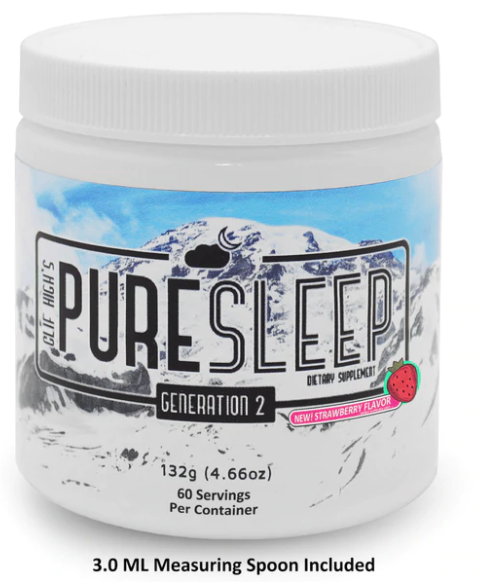


 RSS Feed
RSS Feed
